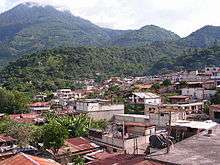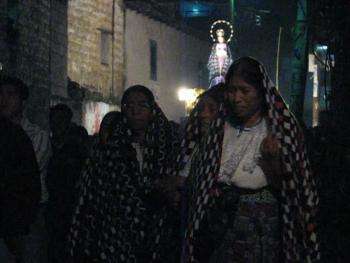San Pedro La Laguna
| San Pedro La Laguna Tz'unun Ya' | |
|---|---|
| Municipality | |
|
View of San Pedro | |
 San Pedro La Laguna Location in Guatemala | |
| Coordinates: 14°41′38″N 91°16′19″W / 14.69389°N 91.27194°W | |
| Country |
|
| Department |
|
| Municipality | San Pedro La Laguna |
| Government | |
| • Type | Municipal |
| Elevation | 1,610[1] m (5,282 ft) |
| Population (Census 2002)[2] | |
| • Total | 9,034 |
| • Ethnicities | Tz'utujil, Ladino |
| • Religions | Roman Catholicism, Evangelicalism, Maya |
| Demonym(s) | Pedrano |
| Climate | Aw |
San Pedro La Laguna (Spanish pronunciation: [sam ˈpeðɾo la laˈɣuna]) is a Guatemalan town on the southwest shore of Lake Atitlán. For centuries, San Pedro La Laguna has been inhabited by the Tz'utujil people, and in recent years it has also become a tourist destination for its Spanish language schools, night life, and proximity to the lake and volcanos.
Local crops include corn, beans, coffee, and avocado. Some women make belts, shawls, and skirts with a back strap loom. San Pedro graduates large numbers of teachers who work the Atitlán area. Activities for tourists include hikes to the top of the San Pedro volcano or the Mayan Face, studying Spanish, partying in the restaurant sector down by the lakeshore, volunteering, and learning local crafts.
Demography
San Pedro La Laguna is a small town with a population of approximately 13,000 people.[3] The inhabitants of San Pedro are primarily Tz'utujil Maya, with a small, but growing, expatriate community. The population is over 90 percent indigenous.[4] The expatriate community that is forming within San Pedro La Laguna is composed of Americans and Europeans.[5]
Religion
The religion that is the most dominant in San Pedro La Laguna is Roman Catholicism. This has been the most dominant religion since the 16th century, when the Spaniards colonized Guatemala.[6]
While Guatemala was under a brutal military regime the North American Protestant Evangelical churches were allowed to enter into any community.[7] As a result of Protestant evangelism, more than 40% of Pedranos are now Evangelical.[8]
Even though the Protestant and Catholic religions have been dominant for many years, about half of the population still practices traditional Maya rituals either separately or alongside another religion. Many locals believe the world is inhabited by both good and bad spirits that influence many aspects of daily life.[9] Xocomil, a wind coming from the south that "carries away sin", usually visits Lake Atitlán area around midday. If the wind is coming from the north, the Maya claim, the lake's spirit is getting rid of a person who has drowned after claiming his or her soul.[10]
Government
San Pedro La Laguna is in the Sololá department of Guatemala. San Pedro La Laguna is separated into four cantons: Pacucha, Chuacante, Chuasanahi, and Tzanjay.[11]
Geography
San Pedro La Laguna is located on the southwestern shore of Lago de Atitlán. The town is located beneath Volcan San Pedro. This volcano towers over the lake at 9,905 feet and is an attraction for climbers and hikers. The town of San Pedro La Laguna sits on a plateau and has roads running down either side of a steep ridge towards docks on the lakeshore. The dock on the west side of the plateau is called muelle municipal and has boats arriving from and departing to the town of Panajachel. The east side has a dock named muelle santiago which has boats arriving from and departing to Santiago Atitlan. The east side is also home to la playa (the beach) where people enjoy snorkeling, canoeing, and kayaking.[12]
San Pedro La Laguna can be reached by regular boats across Lake Atitlán from Panajachel (45 min) and Santiago Atitlán (30 min), or by direct bus from Guatemala City (4 hrs), Xela (3 hrs), and Mazatenango. The town is located one hour off the Interamericana Highway (CA-1) at km 148. Buses for San Pedro depart hourly from zone 8, near the Trébol interchange, alongside Calzada Roosvelt in Guatemala City or, in Xela, from the main bus terminal in zone 3.
History
Civil War
The Guatemalan Civil War spanned the years from 1960 to 1996 (Source). During this time San Pedro La Laguna remained relatively unaffected and unharmed by the surrounding violence. However, from the years of 1980 to 1982 there were a series of kidnappings and murders that took place and shook the community. At first the community was completely fear stricken as they didn't know who was behind these disappearances. As town gossip began to spread and tongues began to loosen it became known that the local military commissioners were, in fact, behind these actions. The local military spent their days in uniform posing as protectors of the community and their nights blacklisting and carrying out murders and kidnappings of local Pedranos. However, instead of blacklisting villagers for disloyalty to the army or for suspicion of collaborating with guerrillas (as was common), most often locals were blacklisted out of vengeance and greed. The military commissioners tried to fool the community by spreading guerrilla type leaflets around the village at night and placed guerrilla graffiti throughout the town. This continued for nearly two years and while it was known who was behind it, little could be done. However, in August 1982 the higher military suddenly came into the village and removed all of the military from the village. Not surprisingly to the locals, calm was quickly restored after their removal. (Harvest of Violence)
Gallery
 A close view of San Pedro La Laguna.
A close view of San Pedro La Laguna. Sunday in the San Pedro La Laguna market with Senior Pedro Gonzalez y Gonzales.
Sunday in the San Pedro La Laguna market with Senior Pedro Gonzalez y Gonzales. San Pedro la Laguna with Volcan San Pedro in the background.
San Pedro la Laguna with Volcan San Pedro in the background. Independence day in San Pedro La Laguna, Oct. 2007
Independence day in San Pedro La Laguna, Oct. 2007
Customs

References
- ↑ McGraw, John J. "Tz'unun Ya'.com". Tz'unun Ya'.com. John J. McGraw. Retrieved 23 March 2012.
- ↑ "XI Censo Nacional de Poblacion y VI de Habitación (Censo 2002)". INE. 2002.
- ↑ Hubbard, Kristen. "San Pedro La Laguna -- Lake Atitlan, Guatemala". About.com. About.com. Retrieved 26 March 2012.
- ↑ McGraw, John J. "Basic Facts". Tz'unun Ya'.com. John J. McGraw. Retrieved 26 March 2012.
- ↑ Hubbard, Kristen. "San Pedro La Laguna -- Lake Atitlan, Guatemala". About.com. About.com. Retrieved 26 March 2012.
- ↑ Morrison, Marion (2005). Guatemala. New York: Children's Press. p. 89. ISBN 0-516-23674-1.
- ↑ Morrison, Marion (2005). Guatemala. New York: Children's Press. pp. 97–98. ISBN 0-516-23674-1.
- ↑ McGraw, John J. "Tz'unun Ya'.com". Tz'unun Ya'.com. John J. McGraw. Retrieved 23 March 2012.
- ↑ Morrison, Marion (2005). Guatemala. New York: Children's Press. ISBN 0-516-23674-1.
- ↑ Stewart, Lain (2009). The rough Guide to Guatemala (4th ed.). New York: Rough Guides. p. 150. ISBN 978-1-84836-017-4.
- ↑ McGraw, John J. "Tz'unun Ya'.com". Tz'unun Ya'.com. John J. McGraw. Retrieved 23 March 2012.
- ↑ Greenspan, Eliot. Frommer's Guatemala. 3rd ed. Hoboken: Wiley Publishing, 2011. Print. p.153.
External links
| Wikimedia Commons has media related to San Pedro La Laguna. |
| Wikivoyage has a travel guide for San Pedro la Laguna. |
- Website of San Pedro La Laguna
- Anthropologist's Blog about learning Tz'utujil in San Pedro La Laguna
- Portal San Pedro La Laguna (.net)
- Website of the Viva San Pedro Magazine
- Video about historic Mayan site, La Nariz, near San Pedro La Laguna
- Demonstration of Tz'utujil Mayan Language, spoken in San Pedro la Laguna
Coordinates: 14°41′38″N 91°16′19″W / 14.694°N 91.272°W